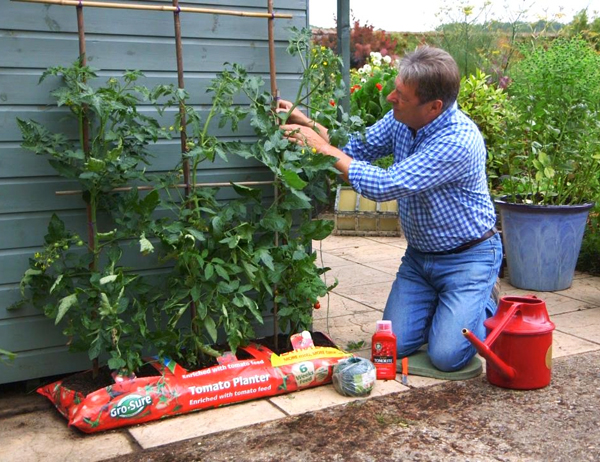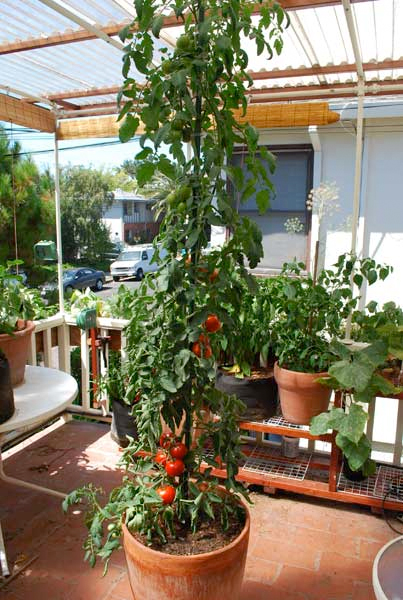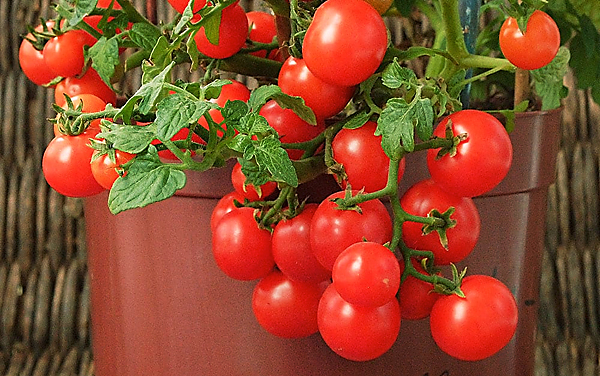
Chapter 33
Growing in Containers
Growing tomatoes in containers is an alternative to growing them in the ground for those who, for whatever reason, cannot have a regular garden. Make no mistake though, the results from growing tomatoes in containers might be acceptable to some but will never be equal or better than those obtained from an actual garden plot.
Growing tomatoes in containers differs greatly from growing in actual garden plot. It's a whole different ball game. To begin with, the watering and fertilizing techniques are nowhere near the same as those employed in a backyard garden. Also, container plants must have much better soil aeration and drainage. This being the case, the particles in their growing medium will be considerably larger than those usually found in garden soil. In addition, growing organically in containers is far less viable as container plantings need fertilizers that are available immediately and cannot rely on nutrients made available by the breakdown of organic materials in the container. To be successful you will have to adopt some new techniques that differ mightily from those employed in an in-ground garden.
Any variety of tomato can be grown in a container but the crowding of roots will likely cause a reduction in the size of the tomatoes grown, especially the giant varieties, unless, of course, the container is quite large. Indeterminate tomatoes can get tall and bushy in larger containers, and so, plant support will be an issue. Despite all the limitations, total crop size can be significant and the taste will be there, particularly when compared to what is available at the grocery store.
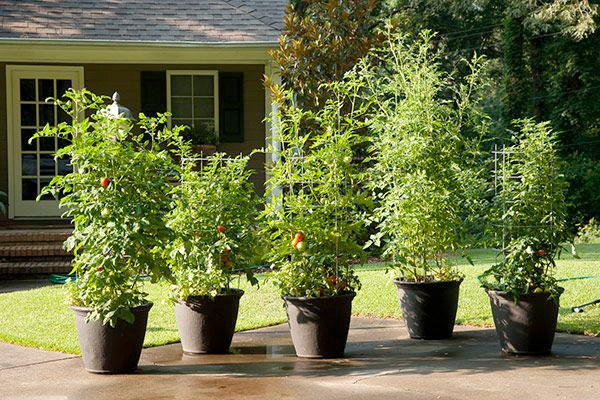
Choosing your Location
Sunlight is important for the growth of all plants, and this includes your container-grown tomatoes. Be sure to place your plants in a sunny area. Tomatoes require 6-8 hours of direct sunlight a day for optimum growth and production. However, when temperatures are high, it is beneficial for the plant to gets some afternoon shade. Try to choose a spot that is sheltered from wind, as strong gusts can damage new plants, will dry the soil out quickly and might blow the plants over. Once you have selected the area for your tomatoes, it is time to start preparing the containers. Keep in mind that since your plants are in containers, and not the ground, they are mobile.
Selecting a Container
What containers should you use and how big should they be? The choices are unlimited and range anywhere from a bucket to a barrel. A 5 gallon container provides what is considered to be the minimum space for a tomato plant's root system. Don't try anything smaller. Lots of tomatoes are successfully grown in 5 gallon buckets but anything smaller is certain to result in root crowding. 5 gallon buckets are cheap and easily obtainable. You can purchase them at any garden outlet store. Bigger is better but if you are limited by space or finances, 5 gallons will do. I suggest bigger with 30 gallons as probably the upper reasonable limit.
There are many possibilities beyond traditional flower pots or buckets for your container garden. Consider the large variety of buckets, half barrels, barrels, window boxes and other containers available. Use your imagination. Recycle some of the containers you have around your house. Keep your eyes open for other people's discards. Also keep in mind that light colored containers are your best choice since in hotter climates the darker the container the more heat it absorbs and the more likely the roots will burn or the plants will dry out.
Proper drainage is important to prevent root rot. By drilling holes in the bottom of your container you will allow for this. A hole about ½ to ¾ inches in diameter is sufficient. You will need at least 4 holes per container, more if it is a large container. The holes should either be in the bottom of the container or low on the sides. Holes low and on the sides will allow you to use your finger to test the moisture level. If necessary, you can cover the holes with screen to prevent soil from falling out.
Do not sit your containers on bare ground. By keeping them off the ground you will prevent disease from potentially entering and destroying your tomato plants. Sitting the pots on plastic or on a board will suffice. Don't use dish-like containers as they will hinder proper drainage from the pot. If you are using something that has been used previously for other plants it is important to scrub it out well before use. This will remove any diseases that might be present from the prior residents.
Choosing a Growing Medium
After choosing your container, you will need to decide what you are going to use as a growing medium. Most growers would agree that a special soil mix is necessary for successfully growing in containers. Soil from your garden, if you have one, will not do. Many use packaged growing materials purchased from their local gardening center. These are highly developed to give your plants everything they need. Commonly used brands include Miracle Grow Potting Mix and Premier Pro-Mix container soil. There are many others on the market.
The basic ingredients of soil-less potting mixtures usually include organic material such as peat moss, redwood sawdust, hardwood bark, pine bark, plus other materials as vermiculite, perlite, pumice, and sand, in different combinations and ratios depending on the product. These mixtures all have several things in common. They allow for fast drainage after watering. They retain air and they retain an appropriate amount of moisture. They do so to different degrees depending on their exact makeup. Regular garden soil is far too dense and does not drain properly, hold enough air, or retain enough moisture for container gardening and so is not recommended. Whatever you use in your pots must be fertile and loose so that the roots can develop to their maximum potential in the limited space available. Regular garden soil, simply put, does not measure up.
Another option to be considered is making your own growing medium and that is what I would suggest. After all, we are growing tomatoes, not cacti. There are many recipes available for container growing mixes. Below is a recipe for Al's 5-1-1 Growing Mix which is recommended by many successful container growers. The amount you will need depends on the size and number of containers you plan to use. You can multiply or divide the recipe as necessary.
Al's 5-1-1 Mix
Recommended on the GardenWeb.com Container Growing Forum
- 2 to 3 cu. ft. pine bark fines
- 5 gallons sphagnum
- 5 to 10 gallons coarse perlite
- 2 cups dolomitic garden lime
- ½ cup micronutrient powder
Pine bark fines are simply small pieces of bark, about the size of a dime, essentially micro nuggets, and about an eighth of an inch thick, some a bit bigger and some a bit smaller. They are sold in gardening centers as pine bark mulch, bark fines or mini-nuggets. Brand names include Vita Bark, Soil-Pep and Royal Gardens Pine Bark Mini-Nuggets. The latter is available at Lowe's. Be certain you do not purchase shredded pine bark mulch! If you are concerned that the size of your pine bark is a bit large, you can double the amount of sphagnum peat moss you add to as to increase moisture retention (A 5-2-1 Mix). If you can find bark that meets the size requirements and has been composted, that is even better since fresh pine bark does use some nitrogen as it degrades. So to this you might want to add a little extra nitrogen.
These materials can be mixed on a tarp and then moistened by misting them with a garden hose. The materials should then be allowed to stabilize for two weeks and then can put in your growing containers and planted. It would be better if they could even compost for a month or so as the bark will take up some nitrogen as it breaks down.
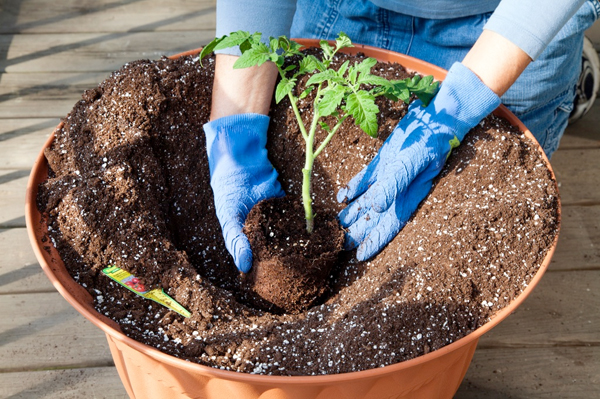
Planting
Plant your tomato plants deep in the containers, at least to the first set of leaves. Better yet, depending on the size of your plants, you might remove the first set of leaves and plant to the second set. New roots will develop along the stems under the soil leading to stronger roots and a healthier plant. Plants grown in containers can be started earlier as you can always bring them inside if there is danger of frost. Be sure to water your plants right after planting.
Watering
The most important technique you need to develop, if you want to successfully grow tomatoes in containers, is when and how to water. The goal of watering in container gardening is to saturate the soil. You must apply enough water to at least dampen the entire soil mass in the container. Also you need to know exactly when to water and this is not as simple as you might think. There is a huge tendency to overwater.
Exactly when do the plants need water? This is dependent on the growing mix you are using, the weather you are having and the kind of container you chose. You definitely do not want your plants to wilt. There are many ways to decide if it is time to water. Here is one that works. You simply check the water level in your container using a dowel rod. Sharpen a 5/16 inch dowel rod in a pencil sharpener. Push the tip of the rod down to the bottom of your container. If it comes out cool or damp, there is no need to water. If it is dry, then water. Try to use the same hole each time you insert the rod so as not to disturb the roots. With a little practice you will know exactly when to water.
Some people like to use moisture meters. You stick the meter rod down into the soil and take a reading. This is better than nothing but understand that water meters measure how much electricity will flow through the soil and are a more accurate measure of conductivity than moisture levels. Still, a moisture meter is better than nothing. You could also use your finger. Stick your finger in a drainage hole to see if it feels moist; this is why side drainage holes were recommended. But don't depend on this totally to tell you when to water as there can be a lot of difference between the top, middle and the bottom of the container. You could also pick up the container to see what it weighs. This would give you an indication of whether the container is wet or dry.
Now that you know the plant needs water, we'll move on to the watering technique. This will most likely be different than anything you have ever done as far as watering. Use a one or two gallon watering can depending on your strength. As you will note below, the water will already have diluted fertilizer present. The growing medium should be so porous that the water disappears immediately into the mix as quickly as it is applied. If it takes longer than 30 seconds to disappear, your growing medium is too dense. The water should move quickly down through the soil. Wait a few minutes and then add more water until you see 10 to 15 % of the water you have added leaching out through the holes in the bottom of the pot. This prevents salt accumulation in your container by flushing salts from the soil. It is not necessary to flush the soil vigorously each and every time you water but the soil should be porous enough that you can do so whenever you like.
Tomato plants must not be allowed to dry out, and outside containers dry out much more quickly in the summer than soil in the garden. During hot weather, you might have to water every day, and, in really hot weather, July and August, maybe more than once a day. To prevent containers from drying out when it is really hot, you may have to move them into the shade or to a spot where they will be shaded partially during the heat of the day. In cool weather you may only have to water every few days.
When you do water, be careful not to wet the plant's foliage, as this increases the chances of mold and spreading diseases from the soil to the leaves. Instead, just water the soil directly with a watering can which will also give you an idea of just how much water you are using. It is better to water in the morning to prevent fungus from growing. When it is really hot it is better to water during the heat of the day.
Never allow your tomatoes to completely dry out. If they wilt from lack of water, water them thoroughly. Water your plants more as the fruit develops and less as it ripens. Tomatoes watered too much right before they are harvested taste watery and may split.
A drip watering system or a water-retaining system with a reservoir such as Earthbox is also an option. This is more complicated than it seems and is beyond our discussion here. However, it is definitely worth looking into and especially for someone who might be absent from their plants for a prolonged period of time and without a friend to care for them.
Fertilizing
Regular feedings are essential for container-grown tomatoes as they are heavy feeders. They need nutrients that are immediately available. Organic fertilizers are designed for outside soil gardens and require bacteria to break them slowly down into useable forms. Although they work in containers, they are erratic and unreliable because the microbes that break them down are variable in number depending on many conditions in the container including the temperature. Chemical fertilizers are best for container growing and are best added in a dilute amount on a regular basis. Slow release fertilizers may be used but you will have less control over the situation. My recommendation is the use of either Miracle Grow Liquid All-Purpose Plant Food 12-4-8 or Dyna Grow Foliage Pro 9-3-6 both of which already contain the needed micronutrients. You can use any fertilizer you like but the NPK ratio should be 3:1:2 and micronutrients are necessary as well. The recommendation is that you add ¼ teaspoon of the liquid fertilizer to each gallon of water and use this solution whenever you water your plants. This is a much diluted fertilizer mix but it is all you actually need. Keep in mind that it will be applied every time you water. There are many techniques for fertilizing container plants but the above is recommended here because it gives good results. Others might too.
For full and very comprehensive discussions of watering and fertilizing container plants go to GardenWeb.com and enter the Container Growing Forum. There are very detailed and excellent discussions there on both topics.

Tomato Support
Either put tomato cages around your containers or stake the tomato plants up once they reach a height of a foot or more. Some tomatoes may not need staking depending on the variety. "Determinate" tomatoes are tomato plants that don't usually require any staking as they grow to a certain height and then stop. "Indeterminate" tomato plants continue to grow and require staking, trellising or cages to prevent their falling over. You are likely to be growing tomatoes that need support and my recommendation is the use of cages. These can be purchased or made from concrete reinforcing wire (see Chapter 14).
Pruning
When the side branches of your tomato plant grow beyond the cage, tuck them back inside the cage. If they extend too far out, you may prune them back. If they extend above the cage it is best to prune them off unless you have a support system that will hold them up. You could also let them grow back down to the ground. Plants can be pruned to one stem and a few suckers or, if you are not going for big, allowed to grow at will. It may take you a season or two of growing to get the hang of pruning.
Conclusion
Growing in containers is a definite option for those who do not have the room or the right space for an in-ground garden. Growing on a deck also offers some protection from many of the tomato eating critters.


